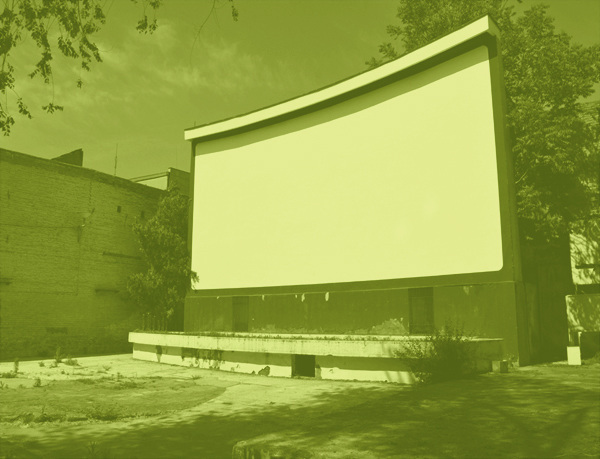Film and video visually exist in disappearance, in between the two frames, as an illusion of a movement induced by a difference in repetition (Deleuze). They are being shown in couple of active cinemas, while there are buildings of old cinema halls that are not functional any longer. They tell about the memory of the city whose structure and cultural programmes have been changing during the entire century, but mostly during transition from socialism into neoliberalism.
The series show buildings of selected cinema halls in one city and their surroundings that had undergo the most changes. The last images show urbanistic plans for restoration of the building designed by August Najar (1924) and the surrounding, turning the old cinema hall into a cultural centre, but also its current state. Since the building is not publicly open, it was not allowed to photograph it, while in front of it is currently placed a parking lot. This is the only old cinema in town that cannot be photo-documented, but also the only one for which are plans in future. The others have entrances publicly accessible, but locked. Those can be seen everyday and photographed, but memories on the time while they worked remain in stories that materially disappear the moment they are being emitted, as films and video works themselves.
Apart from those, there were active Luxor, named later Royal, Urania, Bačka, Radnički (Detelinara district), Danube (in Petrovaradin), as well as numerous cinema halls within cultural institutions, such as the children’s cinema at Cultural Centre of Open University.

Summer cinema Tribina mladih (Youth Platform), “established in 1954 in Novi sad as the first alternative cultural centre in Socialistic Federative Republic Yugoslavia. By the end of 1960s and 1970s, Tribina became the meeting place and centre of the most progressive art scene, literature, theatre and performance from the world, Europe and Yugoslavia. […] It strongly promoted modernist art, freedom of speech and dialogues on contemporary social and political issues” [Pantelić, Zoran and Lukić, Kristian, Trajni čas umetnosti, Frankfurt am Main: Revolver, Archiv für aktuelle Kunst, 2005]. The building was renovated by the beginning of 2011.

Palas, opened in 1940 and renamed into Jadran (Adriatic sea) after WW II. Nearby is renovated façade of the shopping mall “Nork”, previously known as “Promet”, one of the most representative modernist buildings in the city, (Milan Matović, 1971). On the right is programme for film projections at Youth centre CK13, pasted there at the time when Jadran was opened periodically, but people would still come to see if there were some projections scheduled.

Rex, opened in 1940 within a large complex known as Tanurdžić palace (Đorđe Tabaković, 1936), named later Narodni bioskop (People's Cinema) and turned into business space during the 1980s.

Korzo, for more information see: Volić. Ivana and Dajč, Katarina, Graditeljsko nasleđe kao scena: ambijenatalni teatar u funkciji reanimacije, Petrovaradin: Scenatoria, 2013

© Museum of Yugoslav Air Force, the main square photographed after WW I. The marked building is the Appolo cinema. The photograph also shows a part of the Jevrejska Street which was demolished in 1979 prior to building of the Serbian National Theatre and Theatre Square.

Odeon, later named Bioskop Doma JNA (the cinema hall of the Yugoslav People’s Army) was designed by August Nayar and built in 1924. Several metres away was Appolo, the first permanent cinema hall in the town, built in 1911. While it worked, one could smoke cigarettes inside and consume alcohol. During the 1990s, a several rock concerts took place at the place, while it is used now by Bank of Greece as a storage house while in the front there is a parking lot. According to the urban plan of detailed regulation of the protected central area of the city that was approved in April 2011, the nearby square will be reanimated and another new square will be created nearby the Najar’s building which will be completely renovated from the outside and adapted into cultural centre.
